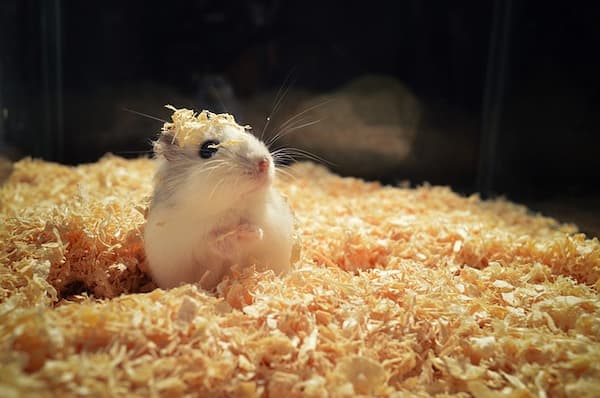A hamster is a tiny animal that can make some intriguing sounds. It’s essential to understand what these noises mean to care for your pet correctly.
Hamsters are incredibly social animals, so they should be kept with others of their kind at all times.
They also require an exercise wheel and lots of toys. Luckily, most people will never hear the more frightening noises because hamsters don’t usually get scared or frightened as often as other critters do.
If you’re considering adopting one, here are some things you need to know before bringing home a new furry friend.
What Sounds Do Hamsters Make?

Hamsters make different sounds depending on how they are feeling. They will squeak, hiss, brux, chirp, and sometimes cough and sneeze.
Hamsters make the same noises for different reasons, so it’s important to know what your hamster is trying to tell you with its body language.
If you just got a hamster, you might be curious about how they talk to each other and their owners, and if they can even make sounds.
I’ll try to describe the sounds that hamsters make and what they mean below. I’ll also talk about hamster body language so you can always understand what your furry friend is trying to say.
1. Squeaking
Most people probably know that hamsters make a squeaky sound. After all, it’s the sound that hamsters make most of the time.
Most of the time, it sounds like a high-pitched, shrill squeak, like what a rubber duck makes when you squeeze it.
Hamsters squeak most of the time, and they do so to show a wide range of emotions, such as happiness, anger, fear, attention-seeking, hunger, and even pain or sickness.
So, it might be hard to figure out exactly what your hamster is trying to say when it squeaks.
The hamster is happy and content if it makes a short squeak every now and then. Sharp noises, especially if they keep happening, can mean that something is wrong or bothering him.
If your hamster is making loud, constant squeaks, you should check on it as soon as possible.
2. hissing
Hissing is a way for hamsters to let you know that something in their living space bothers them.
This is normal for new hamsters because they need some time to get used to their new home.
If your hamster hisses when you’re around, try to move slowly and speak softly.
If he hisses at other pets, you may need to keep them apart until they get used to each other and feel more at ease with each other.
3. Clicking (Bruxing)
When hamsters rub their upper and lower front teeth together, they make a clicking sound. This is also called “bruxing.”
This is a routine that the hamster usually does when it is calm and happy.
4. Chirping
Hamsters can also talk to each other by chirping. Like squeaking, this is a way for them to show different emotions. Most of the time, this sound is soft and high-pitched.
Hamsters make chirping sounds when they are scared, excited, or trying to get attention.
If you have more than one hamster, chirping sounds can mean that they are playing, but they can also mean that they are angry or about to fight, especially if they keep chirping for a long time.
5. Coughing and Sneezing
Hamsters sneeze and cough for the same reason that people do. Your pet might cough or sneeze lightly and temporarily if something bothers him, like dust or a strong smell.
Sneezing and coughing that doesn’t go away can be signs of a cold or allergies.
Food allergies and allergies to things in the air, such as furniture polish, hair sprays, perfumes, and even cigarette smoke, are very common.
If your pet is coughing or sneezing often, you should call your vet as soon as possible. This could be a sign of a serious health problem, like a respiratory infection.
6. Crying and Screaming
A hamster’s scream or cry can be shocking to its owner, whether they hear it up close or see it on a video on the Internet. It is alarming and unsettling in every way.
Even though screaming doesn’t happen very often, when it does, it’s usually because someone dropped their hamster, which hurt or scared the animal enough to make it scream for help.
7. Cooing
Even though hamsters don’t always coo, some owners say that their happy hamsters do make this sound.
Coos are soft, quiet vibrations that come from happy animals. Most of the time, you can hear them when they are eating or playing.
How do hamsters show their emotions?

Hamsters have feelings just like people do, but they can’t tell you how they feel. They need to find a different way to say what they want to say.
Hamsters can talk to their owners by making noises and moving around. But hamsters don’t have vocal cords as people do. They talk to each other with high-pitched chirps and squeaks.
That’s everything you need to know about how to tell how a hamster feels by listening to its sounds.
But there are other things to think about, like allergies, pet noises, and what the hamster might be trying to tell you when it chirps or squeaks.
If our hamster friends are making more noise than usual, they might be scared and need their owners to reassure them. If they’re crying out because they’re hungry, they might need fresh vegetables or a treat made from oats.
You should keep things that scare your hamsters away from them. For example, don’t let your cat or dog near your hamster for the first time if you have one.
How Do Hamsters Communicate with Other Hamsters?
We know that hamsters make a lot of different sounds to show how they feel, but is this the only way they talk to each other or to their owners?
Hamsters talk to each other by making sounds, moving their bodies, and giving off certain chemicals. Let’s look at each category and figure out how hamsters talk to each other in each one.
Sounds
As we’ve already said, hamsters can make a lot of sounds, which is one way they talk to each other.
For example, when female hamsters are in heat and looking for a mate, they chirp and squeak as mating calls. When male hamsters find a female, they make mating calls to let her know they are ready to mate.
When male hamsters chatter their teeth, they are usually scared or angry. But female and intersexual encounters can also make people clench their teeth and act aggressively.
Some hamsters have been known to make ultrasonic sounds to help them find their way because they can’t see well and need help.
But sometimes, especially in Golden Hamsters, ultrasonic sounds are also used as mating calls.
Body Language
When two male hamsters meet, they often use body language to show who is in charge, especially if both hamsters are male.
A common way for two hamsters to meet and get to know each other is for them to circle around and smell each other. The hamsters will keep going around and around until they decide who is the boss.
Hamsters show they are submissive by sitting upright on their hind legs so they can’t be knocked off balance.
Once the positions are clear, the hamsters will spar with each other face-to-face.
The dominant hamster will try to bite the submissive hamster on the belly while the submissive hamster stays still and tries to push him away. So, basically, hamsters protect themselves from danger by standing up.
This might not turn into a fight if one hamster shows peace by putting out one paw and not looking at the other.
Sadly, it usually leads to a fight, which is signaled by high-pitched squeaks.
Most of the time, hamsters fight by rolling around and hurting each other. When one hamster stops moving and freezes in a belly-up position, the fight is over.
But sometimes the dominant hamster will try to chase the submissive one, which can be dangerous if the submissive hamster is in a cage and can’t get away.
You can stop them from fighting by spraying them with water.
Chemical Cues
Hamsters can also talk to each other by smelling each other. Hamsters do this by using their smell glands to mark their territory and show who is boss.
Different kinds of glands are found in different kinds of hamsters. Syrian, Turkish, Romanian, and Roborovski hamsters all have two scent glands, one on each hip, on their flanks.
On the other hand, dwarf hamsters like Winter White or Campbell’s hamsters have six sets of scent glands. They are on their genitalia, their bellies, and their ears.
Happy Hamster Sounds
A happy, healthy hamster might show their appreciation by letting off some short, shrill squeaks of excitement.
They also create a clicking noise, known as bruxing, which is when they rub their lower and upper teeth together.
This is often a ritual they partake in when they are feeling calm and content.
Do Hamsters Make Noises at Night?
Yes, hamsters do make noise at night. Hamsters are nocturnal, which means they are active at night and make noise.
There are ways to make the noises your pet makes less loud. Even if you give your hamster a toy or some bedding, it will still make noise during the day.
- Put your hamster’s cage in a room that isn’t near your bedroom, and use a cage or wheel that doesn’t make a lot of noise.
- Putting hamsters in their cage is easier when they are tired than when they are full of energy. When you try to pick them up, they will use their strength to get away.
Conclusion
Most of the time, hamsters are quiet, unobtrusive pets that only let us know they are there when they chew on their bars or run in their wheels.
And while they might show how they feel through actions like jerking, grooming, or sniffing, they probably won’t say anything out loud.
But if your hamster squeaks, squeals, screams, or hisses, you can’t ignore what they’re trying to tell you. Instead, give them more space and reassurance so they can feel happy and at home.






